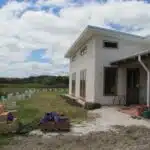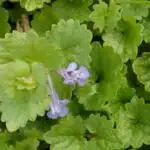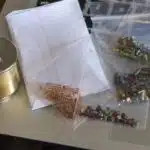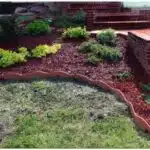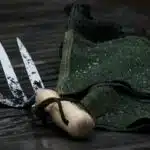As a landscape fabric installation expert, I have encountered numerous clients who struggle with weed control in their gardens and landscapes. Weeds are not only unsightly but also compete with desirable plants for nutrients, water, and sunlight. Furthermore, manual weeding is a tedious and time-consuming task that most homeowners dread. Fortunately, there is a reliable solution to this problem- installing landscape fabric.
Landscape fabric is an effective weed control method that creates a barrier between the soil and the weed seeds, preventing them from germinating and growing. It is also permeable enough to allow air, water, and nutrients to pass through to the plant roots. However, installing landscape fabric requires some skill and knowledge to ensure it works optimally. In this article, I will provide you with a step-by-step guide on how to install landscape fabric for weed control in your garden or landscape.
Understanding The Benefits Of Landscape Fabric For Weed Control
Landscape fabric has become a popular choice among gardeners and landscapers due to its numerous benefits. Compared to traditional weed control methods such as hand weeding or chemical sprays, landscape fabric provides a more effective and long-lasting solution. It is a woven or non-woven material made from polypropylene or polyester that allows water and air to penetrate while suppressing weed growth.
One of the main advantages of using landscape fabric is the reduction in maintenance time and costs. By preventing weeds from growing, it eliminates the need for regular weeding, which can be time-consuming and physically demanding. Additionally, landscape fabric helps retain moisture in the soil, reducing the amount of watering needed for plants to thrive. This means less time spent on watering and lower water bills in the long run.
To maintain the effectiveness of landscape fabric over time, proper installation and maintenance are crucial. Installing it correctly involves ensuring an even coverage with no gaps or overlaps, securing it with staples or pins every few feet along the edges, and cutting holes for planting. To prevent soil erosion and preserve its integrity, mulch should be added on top of the fabric. Regular inspection for tears or damage is also important, as repairing these issues promptly will prolong its lifespan.
When it comes to choosing the right type of landscape fabric for your project, there are several factors to consider such as weight, permeability, UV resistance, and durability. These will be discussed in more detail in the next section to help you make an informed decision that best suits your needs.
Choosing The Right Type Of Landscape Fabric
When it comes to weed control, landscape fabric is an excellent solution. It blocks out light and prevents weeds from growing while still allowing water and air to pass through. However, with so many types of landscape fabric available, choosing the right one can be overwhelming.
To help you make an informed decision, here are the pros and cons of different landscape fabric materials:
Woven Landscape Fabric – This type of fabric is made from polypropylene and is the most durable option available. It’s perfect for areas with heavy foot traffic or where heavy equipment may be used. However, it also allows some weeds to grow through due to its porous nature.
Non-Woven Landscape Fabric – Made from polyester or polypropylene fibers that are bonded together, non-woven landscape fabric is ideal for use under mulch or decorative rock. It’s also great for preventing soil erosion on slopes but may not hold up as well under heavy foot traffic.
Natural Fiber Landscape Fabric – If you’re looking for an eco-friendly option, natural fiber landscape fabric made from materials like jute or hemp is a great choice. It’s biodegradable and adds nutrients to the soil as it decomposes over time. However, it may not last as long as synthetic options and may allow some weeds to grow through.
By understanding the different types of landscape fabric available and their respective pros and cons, you can choose the best one for your needs. Once you’ve made your selection, measuring your garden or landscape is the next crucial step in ensuring a successful installation process.
Measuring Your Garden Or Landscape
Measuring accuracy is vital when it comes to installing landscape fabric for weed control. Before beginning the installation process, it is essential to measure your garden or landscape accurately. This will ensure that you purchase the correct amount of landscape fabric and avoid wastage. Not measuring your garden correctly can result in not having enough fabric, which means that weeds will still grow through the uncovered areas.
To measure your garden or landscape accurately, you need a few tools. You will need a measuring tape, stakes, string, and a marker. Start by marking out the perimeter of your garden using stakes and string. Next, divide the marked area into smaller sections for easier measurement accuracy. Measure each section individually and record the measurements on paper. Add up all the measurements to get an overall area size.
Measuring your garden accurately is crucial to ensure that you have enough landscape fabric to cover all areas effectively. By using simple tools such as a measuring tape, stakes, string, and a marker, you can measure accurately and avoid wasting money on extra fabric that may go unused. The next step in installing landscape fabric for weed control is clearing the area of debris and weeds before laying down the fabric.
Clearing The Area Of Debris And Weeds
While it may seem like a tedious task, clearing the area of debris and weeds is an essential step in installing landscape fabric for weed control. Some may argue that simply laying the fabric on top of existing vegetation will suffice, but this is not the case. Any plant material left underneath the fabric can continue to grow and push through, rendering the fabric ineffective.
There are several techniques for clearing the area before installation. One option is to manually remove all visible weeds and debris using hand tools such as rakes or shovels. Another method involves using herbicides to kill off any remaining vegetation. However, caution should be exercised when using chemicals near desired plants or bodies of water.
Disposal methods for cleared debris will vary depending on location and local regulations. In some areas, green waste can be composted or recycled, while in others it must be disposed of at a designated facility. It’s important to research and follow proper disposal protocols to avoid any negative environmental impacts. Once the area has been thoroughly cleared and any necessary disposal measures have been taken, you can move on to preparing the soil for landscape fabric installation.
Preparing The Soil For Fabric Installation
After clearing the area of debris and weeds, it is now time to prepare the soil for landscape fabric installation. Soil preparation is crucial as it will determine how effective the fabric will be in controlling weeds. The first step in preparing the soil is to test it for pH levels and nutrients. This will help you determine if your soil needs any amendments before installing the fabric.
Once you have tested your soil, it’s time to amend it if necessary. This can include adding compost or other organic matter to improve soil structure and fertility. After amending the soil, rake it smooth and level for even fabric installation. It’s also important to remove any large rocks or debris that could puncture or tear the fabric.
Proper soil preparation is essential for successful landscape fabric installation. Taking the time to test and amend your soil will not only improve weed control but also promote healthy plant growth. In the next section, we will discuss how to install edging materials to secure your landscape fabric in place and prevent weed growth along the edges of your planting beds.
Installing Edging Materials
When it comes to installing landscape fabric for weed control, it’s important to not just focus on the fabric itself, but also the edging materials that will keep the fabric in place. There are several different types of edging materials available, each with their own pros and cons.
One option is plastic edging, which is affordable and easy to install. However, it can become brittle over time and may not hold up well in extreme weather conditions. Another option is metal edging, which is more durable but also more expensive. It’s important to choose an edging material that will complement your landscape design while also providing the necessary support for your landscape fabric.
Ultimately, choosing the right edging material will ensure that your landscape fabric remains in place for years to come, effectively controlling weeds and promoting healthy plant growth. In the next section, we’ll explore how to properly lay down and secure landscape fabric using your chosen edging materials.
Laying Down The Landscape Fabric
Laying down the landscape fabric is a crucial step in preventing weeds from growing in your garden. Before you start, make sure to clear the area of debris and remove any large rocks or roots that may puncture the fabric. Next, unroll the fabric and lay it flat over the soil, ensuring that it covers the entire area you want to protect. Use landscape pins to secure the edges of the fabric in place.
One benefit of using landscape fabric is that it can help retain moisture in your soil by reducing evaporation. This means less watering for you, which saves time and money. Additionally, mulching on top of the fabric can further improve moisture retention while also providing additional weed control.
While landscape fabric is an effective way to control weeds, there are alternative methods available as well. Some gardeners prefer using organic mulches such as straw or leaves instead of synthetic fabrics. Others opt for hand pulling or using herbicides to keep their gardens weed-free. It’s important to choose a method that works best for your specific needs and preferences.
To prepare for cutting the fabric to fit around plants and obstacles, make sure you have a good pair of scissors or utility knife on hand. It’s important to cut carefully so as not to damage any nearby roots or plants. Take your time and work slowly, making small cuts as needed until you have created openings for all of your desired plants and features.
Cutting The Fabric To Fit Around Plants And Obstacles
After laying the landscape fabric over the soil, it’s time to cut it to fit around plants and obstacles. This step is crucial in ensuring that the fabric covers all areas where weeds are likely to grow. To begin, first locate any existing plants or shrubs that you want to protect. Make a small slit in the fabric with a pair of scissors and gently pull the fabric away from the plant. Cut an “X” shape into the fabric and fold back each corner so that your plant can fit through comfortably.
Plant protection is vital when installing landscape fabric. Cutting too close to your plants may result in root damage, which could potentially kill your vegetation. To avoid this, use a sharp pair of scissors or utility knife and take your time when cutting around plants. Take note of any roots that may be exposed during the process and cover them back up with soil.
Obstacle management should also be considered when cutting the landscape fabric. Large rocks or other obstructions should be removed before laying down the fabric, but if they cannot be removed, then simply cut around these obstacles as best you can while leaving a few inches extra material around them. Obstacles such as irrigation systems or decorative elements can also be cut around using this same technique.
| TIP | | — | — | | Always make sure to leave an extra inch or two of material when cutting around obstacles such as irrigation systems or decorative elements.|
Incorporating plant protection and obstacle management during landscape fabric installation will ensure that your garden remains weed-free for years to come. By carefully cutting and fitting the fabric around your vegetation and obstructions, you will minimize damage while maximizing effectiveness against unwanted weeds. The next step is securing the fabric with landscape staples or pins to keep it in place over time.
Securing The Fabric With Landscape Staples Or Pins
To secure the landscape fabric, it is essential to use landscape staples or pins. These are small, U-shaped pieces of metal that penetrate the soil and hold the fabric in place. There are several types of staples available in the market, including steel and plastic options. Steel staples have a longer lifespan and can withstand harsh weather conditions, while plastic ones are ideal for temporary installations.
To apply the staples, start at one end of the fabric and work your way towards the other end. Space them approximately six inches apart along the edges and twelve inches apart in the middle. It is important not to over-staple as this can damage both the fabric and plants growing nearby.
Alternative methods for securing landscape fabric include using rocks or bricks. While these may be effective, they can also cause damage to both the soil and plants if not placed carefully. Therefore, using landscape staples or pins is still considered the best method for securing landscape fabric.
When securing landscape fabric with staples or pins, it is important to ensure maximum coverage by overlapping each section by at least one inch. This will prevent weeds from finding their way through gaps in between sections of fabric. A good tip is to use a straight edge such as a board or ruler to keep overlapping consistent throughout the installation process.
Overlapping The Fabric For Maximum Coverage
- Properly overlapping the fabric is crucial for maintaining maximum coverage and weed control.
- Determining the amount of overlap for the fabric can vary depending on the type of fabric used.
- Securing the fabric with pins is recommended to ensure the fabric does not shift or become loose over time.
- The pins should be placed at the seam of the overlap, ensuring the fabric is held firmly in place.
Determining Overlap Amount
To ensure maximum coverage and effectiveness of landscape fabric for weed control, proper overlap techniques must be implemented. Determining the amount of overlap is crucial to prevent unwanted weed growth and to create a seamless barrier between the soil and fabric. The ideal overlap amount depends on various factors such as the type of fabric used and the width of the material.
When choosing a landscape fabric, it’s important to consider its width. Most fabrics come in widths ranging from 3 feet to 12 feet. A wider fabric may require less overlapping than a narrower one, but it all depends on the layout of the area being covered. When overlapping fabrics, it’s recommended to have at least 6 inches of overlap between sections for maximum coverage. However, if there are areas with high traffic or prone to erosion, it’s best to increase the overlap amount up to 12 inches.
Another factor that affects determining overlap amount is how steep or sloped the area is. For steep slopes, more overlap is needed for better anchoring and stability. It’s also essential to secure the overlapped sections with landscape pins or staples every few feet along the seam line. By taking these considerations into account when installing landscape fabric, homeowners can effectively control weeds while maintaining an attractive outdoor space without much maintenance required.
Securing Fabric With Pins
After determining the ideal overlap amount for landscape fabric installation, it’s crucial to secure the overlapped sections with pins or staples to prevent shifting and maintain maximum coverage. There are various types of pins available in the market that homeowners can choose from depending on their budget and preference. Steel or plastic U-shaped pins are common and affordable options that can effectively anchor the fabric in place. However, galvanized steel staples provide better stability and are recommended for areas with high traffic or prone to erosion.
When installing landscape fabric with pins, it’s essential to follow some tips for optimal results. First, make sure to place the pins at least 6 inches away from the edge of the fabric to avoid tearing. Second, hammer the pins firmly into the ground at a 45-degree angle to ensure they hold well. Third, space out the pins every few feet along the seam line to secure both layers of fabric evenly. Lastly, avoid overlapping too many layers of fabric as this may cause unevenness in the ground surface.
If replacing old landscape fabric with new ones, removing old pins or staples is necessary before installing new ones. A pair of pliers can be used to pull out old steel staples while plastic U-shaped pins can be removed by cutting them at ground level with pruning shears. It’s also crucial to remove any weed growth between layers of old fabrics before laying down new ones for maximum effectiveness. By following these tips, homeowners can secure their landscape fabric effectively and prevent unwanted weed growth while maintaining an attractive outdoor space.
Creating Holes For Planting
When installing landscape fabric for weed control, it is important to make sure that there are enough holes for your plants. Planting techniques are crucial in this step of the process. It is vital to take note of the distance between each hole as well as its size to ensure optimum growth conditions for your plants.
Before creating holes, soil preparation must be done beforehand. The area where you will install the fabric should be cleared of any debris and leveled. Rake and remove all rocks, roots, and weeds that may hinder plant growth. Afterward, loosen up the soil with a tiller or garden fork to create an optimal environment for your plants’ root system.
Now it’s time to start creating holes using a sharp object like scissors or a knife. Make sure that the cuts are clean and neat to avoid damaging the fabric’s integrity. Cutting too small or too large holes may affect plant growth negatively. Keep in mind that proper spacing between holes is also essential in maintaining a healthy growing environment. Once done, you can now proceed with adding mulch on top of the fabric to further improve moisture retention and prevent weed infiltration into your planting beds.
Adding Mulch On Top Of The Fabric
- There are various types of mulch to choose from, such as bark, gravel, and shredded rubber, each with their own advantages and disadvantages.
- The chosen mulch should be spread evenly over the landscape fabric, taking into account the depth and amount of coverage desired.
- The mulch should be kept away from the edges of the fabric to prevent it from shifting.
- A layer of edging should be added around the perimeter of the fabric to create a clean and finished look.
- This edging can be made from a variety of materials, including metal, stone, and plastic.
- Care should be taken to ensure that the edging is securely fastened and level with the ground to prevent it from shifting or becoming uneven.
Types Of Mulch
Mulching is an essential component of any successful landscape fabric installation project. The benefits of mulching are numerous, including weed suppression, moisture retention, and soil temperature regulation. When it comes to choosing the right type of mulch for your landscape, there are several options available.
One common type of mulch is wood chips or bark. These materials provide excellent weed control and help retain moisture in the soil. They also break down slowly over time, releasing nutrients into the soil as they decompose. However, wood chips can be expensive to purchase and may require frequent reapplication.
Another option is straw or hay mulch, which is a cost-effective choice that also helps suppress weeds and retain moisture in the soil. However, straw or hay may contain seeds that can sprout and create unwanted weeds in your garden.
Gravel or rock mulch is a low-maintenance option that provides excellent drainage and adds visual interest to your landscape design. However, it does not provide any nutrients to the soil and can be more challenging to remove if you decide to change your garden layout.
In conclusion, choosing the right type of mulch for your landscape fabric installation project depends on a variety of factors such as cost, maintenance level desired, and aesthetic preference. Each type of mulch has its own advantages and disadvantages that should be considered carefully before making a decision. By selecting the appropriate mulch for your garden’s unique needs, you can ensure long-term success with minimal hassle.
Spreading Mulch
Spreading mulch on top of the landscape fabric is a critical step in any successful installation project. Mulching helps retain moisture and regulate soil temperature, while also suppressing weed growth. There are several types of mulch materials to choose from, including wood chips, straw or hay, and gravel or rock.
When spreading mulch over landscape fabric, it is essential to apply a layer that is at least 2-3 inches thick. This depth ensures that the mulch will effectively suppress weeds while retaining moisture in the soil. Additionally, thicker layers of mulch can help regulate soil temperature by insulating plant roots from extreme heat or cold.
It is important to note that when adding mulch on top of landscape fabric, it is best to avoid piling it up against tree trunks or plant stems. This can trap moisture against the bark and lead to rot or disease. Instead, leave a small gap between the base of trees or plants and the edge of the mulched area for proper air circulation. By following these guidelines for spreading mulch over landscape fabric, you can create a healthy and thriving garden environment that benefits both your plants and your overall landscape design.
Finishing With Edging
After spreading mulch on top of the landscape fabric, the next step is to finish the installation process with edging. Edging is essential in creating a clean and defined border around your garden beds or walkways. It also helps keep the mulch from spilling over onto other areas, preventing it from becoming a tripping hazard. There are several types of edging materials to choose from, each with its own pros and cons.
One option for edging is plastic or metal strips that can be easily installed by hammering them into the ground. This type of edging material is low-cost and readily available but may not provide as much durability as other options. Another option is natural stone, which adds a beautiful and rustic touch to your landscape design. However, it tends to be more expensive and requires professional installation.
For those who prefer a more eco-friendly option, there are also various types of recycled plastic or rubber edging materials available. These materials are durable, easy to install and remove, and come in a variety of styles and colors. Ultimately, the choice of edging material will depend on personal preferences, budget constraints, and desired level of durability.
In conclusion, finishing your landscape fabric installation project with proper edging is crucial for creating a polished look while also preventing mulch from spilling over onto unwanted areas. There are several types of edging materials available for you to choose from depending on your preferences and budget constraints. By following these guidelines for adding mulch on top of the fabric and finishing with appropriate edging options will help create an aesthetically pleasing garden environment that serves both functional purposes while benefiting the overall beauty of your landscape design.
Watering The Fabric And Plants
Now that you have installed your landscape fabric, it is time to start watering your plants. Proper watering is essential for the health of both your plants and fabric. Watering helps to keep the soil moist and prevent weed growth. It also ensures that the fabric stays in place and does not get blown away by the wind.
To water your plants and fabric effectively, water slowly and deeply. This will allow the water to penetrate deep into the soil and reach the roots of your plants. Give each plant enough water to moisten the soil around it, but be careful not to overwater as this can lead to root rot. Here are some watering tips you can follow:
- Water early in the morning or late in the evening when it’s cooler.
- Use a soaker hose or drip irrigation system to deliver water directly to the roots of your plants.
- Avoid getting water on top of the fabric as this can cause it to break down over time.
Proper maintenance techniques are crucial for keeping your landscape fabric in good condition. Besides watering, there are other things you can do to ensure that your fabric lasts for many years. Regularly check for any tears or holes in the fabric, and patch them up immediately if you find any. Also, make sure that any mulch or debris that accumulates on top of the fabric is removed regularly. Doing so will prevent weed growth and keep your garden looking neat and tidy.
Transition: While proper maintenance techniques are important, monitoring your landscape fabric is equally essential for optimal performance. In the next section, we’ll discuss how you can monitor and maintain your fabric effectively without damaging it inadvertently.
Monitoring And Maintaining The Fabric
After installing landscape fabric, it is important to monitor and maintain the edges of the fabric. Over time, the fabric may become exposed due to weather conditions or foot traffic, allowing weeds to grow through. To prevent this from happening, regularly check the edges of the fabric and secure any loose areas with fabric pegs or staples. If necessary, add a layer of mulch over the edges to further prevent weed growth.
Another important aspect of maintaining landscape fabric is preventing erosion. Heavy rain or wind can cause soil to wash away from under the fabric, leaving it vulnerable to damage and creating gaps for weeds to grow through. To prevent erosion, ensure that the soil under the fabric is well-compacted before installation. Additionally, consider using a layer of gravel or rocks around the perimeter of the area covered by landscape fabric to provide extra stability.
By properly monitoring and maintaining your landscape fabric installation, you can greatly reduce weed growth in your garden or landscaping project. Remember to regularly check and secure edges as needed and take steps to prevent erosion for long-lasting results.
Transitioning into troubleshooting common issues with landscape fabric installation: However, even with proper maintenance, issues may arise during installation or after prolonged use. It’s important to know how to troubleshoot these common problems in order to maximize the effectiveness of your weed control efforts.
Troubleshooting Common Issues With Landscape Fabric Installation
Maintaining the Landscape Fabric is essential to ensure its effectiveness in controlling weed growth. One of the most common mistakes when installing landscape fabric is not monitoring it regularly. It is important to check the fabric every two weeks to ensure that there are no wrinkles or damages that can create gaps for weeds to grow through. This helps in preventing weed growth and ensures that the fabric remains effective.
Another common mistake during installation is not avoiding wrinkles. Wrinkles on the fabric can result in water pooling, which ultimately leads to mold growth and weakening of the material. To avoid this, it is crucial to properly level and smooth out the ground before laying down the fabric. Additionally, it is recommended to use anchor pins or staples to secure the edges and prevent any movement, which can cause unwanted wrinkles.
If you encounter issues such as weed growth or damage to the landscape fabric after installation, do not panic. Troubleshooting these problems requires careful inspection and identification of their root causes. Some common issues include improper installation, insufficient overlap between sections, or incorrect choice of material for your specific needs. By understanding these potential problems beforehand, you can take necessary precautions while installing landscape fabric and ensure that it remains a beneficial tool in controlling weed growth for many years to come.
By following proper maintenance strategies such as regular monitoring and avoiding wrinkles during installation, you can guarantee long-lasting benefits from your landscape fabric investment. These practices help maintain its efficacy against unwanted weed growth while preserving its durability over time. Remember that by being proactive and taking care of your landscape fabric investment now, you are ultimately saving yourself time, money, and stress in the future!
Conclusion
Landscape fabric is a highly effective solution for controlling weeds in gardens and landscapes. By preventing sunlight from reaching the soil, this fabric inhibits weed growth while still allowing air and water to penetrate. It also helps retain moisture in the soil, reducing the need for frequent watering. To install landscape fabric, choose the right type for your needs, measure your garden or landscape, clear the area of debris and weeds, prepare the soil, add mulch on top of the fabric, water it well, monitor and maintain it regularly.
When installing landscape fabric, it’s important to follow these steps carefully to ensure long-lasting results. One common issue that can arise is tearing or damage to the fabric during installation or maintenance. This can be avoided by choosing a high-quality product and taking care when handling it. Another common problem is inadequate coverage of the fabric, which can allow weeds to grow through gaps in the material. To prevent this from happening, make sure to overlap seams by at least 6 inches and cover all areas thoroughly.
In conclusion, using landscape fabric is an excellent way to control weeds in your garden or landscape. By following these guidelines for installation and maintenance, you’ll enjoy a beautiful and weed-free outdoor space with minimal effort required. Remember that proper preparation and attention to detail are key factors in achieving optimal results with any landscaping project. So take your time and do it right – your plants (and your wallet) will thank you! And if you’re feeling overwhelmed or unsure about any aspect of this process, don’t hesitate to consult with a professional landscaper or gardening expert who can provide helpful advice and support along the way. After all, “measure twice, cut once” – investing a little extra time upfront will pay off in spades down the road!
Image Credits
- “The Fabric Landscape” by Sebastian Mary (featured)


